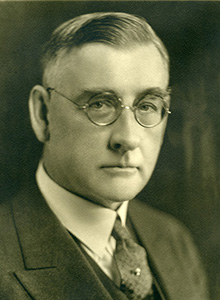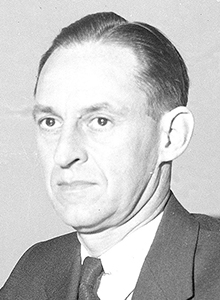
Matthew J. Fleming
- President, Federal Reserve Bank of Cleveland, 1935–1944
- Born: June 4, 1879
- Died: July 14, 1962
Matthew J. Fleming became the second governor of the Federal Reserve Bank of Cleveland in 1935.
Born in Indiana in 1879, Fleming began his banking career as a messenger at the Third National Bank in Pittsburgh in 1898. He then became an auditor at Farmer’s Deposit National Bank, also in Pittsburgh.
Known as “M.J.,” Fleming joined the Cleveland Fed in 1914 as a member of its original staff of officers, serving as the first auditor when the Bank opened its doors. During that time, he was in charge of the Fiscal Agent’s Department and made significant contributions to the success of the Liberty Loan Drives during World War I. After serving as assistant to the governor, Fleming was appointed deputy governor in 1920 and governor in 1935. A year later, he became president when the title was officially changed by the 1935 Banking Act.
During his tenure at the Cleveland Fed, Fleming was on loan to the Reconstruction Finance Corporation in Washington, DC, for ten months, creating the Cleveland Loan Agency and serving as its manager. When he returned to Cleveland, he actively advised the city’s chamber of commerce in their trade expansion program.
Along with Elvadore Fancher, Fleming was instrumental in the design and construction of the Cleveland Fed’s landmark ten-story building on Superior Avenue and E. 6th Street, where operations continue today. He served on the Federal Open Market Committee and on a number of other System committees that examined operations and bank reserves. He was known in the banking world for his thorough understanding of bank operations and his practical and exemplary problem-solving skills.
Fleming retired as president on September 15, 1944, after forty-six years in the banking field, thirty of them at the Cleveland Fed. He was succeeded by Ray M. Gidney.
Fleming realized his childhood dream of becoming a banker and was also active in his community, where he was a longtime member of the American Institute of Banking and the Rotary Club of Cleveland and a high-ranking Mason in the Forest City Lodge.
He was married to his wife, Edna, for fifty years; they had two sons and a daughter as well as many grandchildren and great-grandchildren. He died in St. Petersburg, Florida, in 1962.
Written by the Federal Reserve Bank of Cleveland. See disclaimer.





